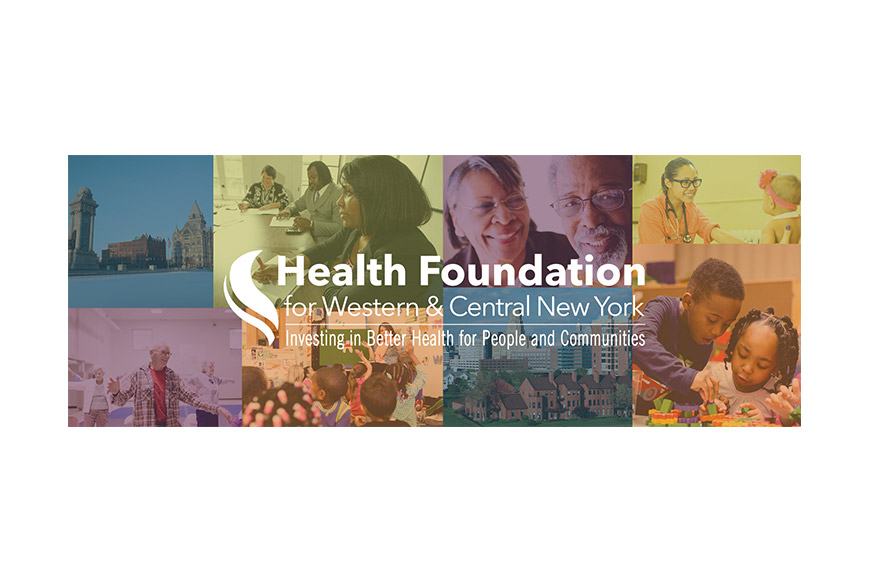What’s New at the Health Foundation?
Happy Spring! While we wait for the weather to catch up to the calendar, we’re excited to share what’s been happening lately at the Health Foundation for Western and Central New York.
In this issue, you can find out about the results of our recent stakeholder survey from The Center for Effective Philanthropy, learn about how we’re working to keep kids cavity free and check out a new policy brief on the Triggers of Decline we developed with our partners at the Syracuse University Institute of Aging.
Make sure you don’t miss out on information about funding opportunities, RFPs, grants, projects, news and events by visiting our website. You can also follow us on Facebook, Twitter, or LinkedIn.
Have news or comments you’d like to share with us? Please email kmclaughlin@hfwcny.org.
Center for Effective Philanthropy report shows stakeholder
ratings for Health Foundation improve overall
Last year, we commissioned The Center for Effective Philanthropy to conduct an Assessment Report of our stakeholders and we’re happy to share with you the key findings from this report.
The STAR provides comprehensive analysis and comparative data that helps us understand how our performance in several key areas is perceived by audiences such as non-profit organizations, other funders, government officials and community leaders.This is the second time we’ve commissioned a Stakeholder Assessment Report; the first survey was completed in 2010.
Back in 2010, though stakeholders overall rated the Foundation positively, they were less positive about the Foundation’s impact, and particularly about the Foundation’s effect on public policy.
Stakeholder perceptions also varied significantly by region, with stakeholders in central New York having a much less favorable view of the Foundation than stakeholders in western New York or outside of either region.
We took the results of that survey seriously and developed an action plan to address any areas where we saw that we needed to improve.
Staff set out to improve our communication of the foundation’s role and impact in the communities we serve; improve the effect of the Foundation’s work on public policy; and increase the Foundation’s visibility and presence, particularly in central New York. Steps included bringing on additional staff, expanding the presence of the Foundation in central New York, increasing our outreach into the community and increasing our focus on public policy where relevant.
To find out what progress we’ve made in achieving those objectives, CEP surveyed more than 1,000 stakeholders in June 2015, receiving 365 completed responses for a 34 percent response rate. Thank you to everyone who took the time to participate in the survey, we value and appreciate your feedback.What we found was that overall, our 2015 stakeholder ratings have improved since 2010, and are now similar to, or even more positive than other similar funders’ stakeholder feedback.
Cavity Free Kids teaches preschoolers healthy dental habits
As morning snack is wrapping up, preschoolers in Head Start classrooms across western New York are gathering in groups to swish and swallow, and to brush their teeth. “It’s now become a competition to see who can brush harder,” said Theresa Wells, coordinator of health, disparities and nutrition for Cattaraugus Wyoming Counties Project Head Start. “We aren’t changing behaviors, we are instilling them.”
Introducing the positive habit of brushing your teeth twice a day is a small piece of the Cavity Free Kids curriculum that is being taught weekly to preschoolers in western and central New York. A rich collection of lessons, activities, stories and songs actively engage young chidlren in fun-filled, play-based learning, while the curriculum places an additional emphasis on practicing good oral health habits at home.
“Brushing is really important in our house. I really appreciate the curriculum because good oral hygiene is taught at home, and it is carried over and reinforced in school,” said Dayna Barker, whose son Jayden attends Northwest Academy Head Start in Buffalo, NY.
According to the American Academy of Pediatric Dentistry, tooth decay is the single most common chronic childhood disease – five times more common than asthma, four times more common than childhood obesity and 20 times more common than diabetes. And dental disease is disproportionately concentrated among disadvantaged children, especially those who qualify for Medicaid coverage.
Cavity Free Kids, part of our CHOMPERS! Bringing Dental Care to Kids initiative, is a best practice oral health curriculum developed by the Washington Dental Service Foundation. We launched the program in 2010 and work with organizations throughout western and central New York to help children in both regions develop lifelong dental habits and better oral health. Read more….
Fifth class of Health Leadership Fellows graduates at May 2 event
Thirty-six leaders from health-related and safety net organizations across western and central New York graduated from our Health Leadership Fellows program at an event Monday, May 2, 2016 at the Strong Museum in Rochester, NY.
For this fifth cohort of Fellows, the event marked the end of the intensive 18-month program, which included four two- to three-day residential sessions on topics including personal leadership, leading change, communicating as a leader and results-based leadership and collaboration. Ongoing learning happened between sessions, where fellows worked together on an inter-organizational project in small teams.
Each fellow also got executive coaching and access to the program’s learning materials.
New policy brief introduces ‘Triggers of Decline’ model
As a funder in the aging sector, we’re focused on improving the health of vulnerable older adults and ensuring that they can lead a dignified, independent, high quality life in their community.
So to identify the factors that that have the potential to trigger frailty or functional decline in vulnerable older adults living in the community, we partnered with the Syracuse University Aging Studies Institute to develop a new “Triggers of Decline” conceptual model.
As explained in a new policy brief “Identifying Interventions to Address Triggers of Decline in Vulnerable Older Adults,” triggers of decline are events that precipitate a decline in physical, cognitive, or mental health for otherwise healthy older adults living in the community. Read more…
What We’re Learning
“Syracuse Hospital has lowest C-section rate in the U.S., report shows”
According to a Consumer Reports investigation, Crouse Hospital in Syracuse has the lowest rate of cesarean sections among big hospitals in the nation. C-section rates at Crouse Hospital are 11.3 percent, while the nationwide average is approximately 33 percent.
“Falls Among Persons Aged 65 Years and Older With and Without Severe Vision Impairment”
The Centers for Disease Control and Prevention analyzed data from the 2014 Behavioral Risk Factor Surveillance System to estimate the state-specific prevalence of falls among people aged 65 and older with and without severe vision impairment.
Upcoming Events
Watch your inboxes for a Save the Date for the next ‘Western New York Performing Providers Systems: Care for the Future 6-Month Update’ event later this year!



